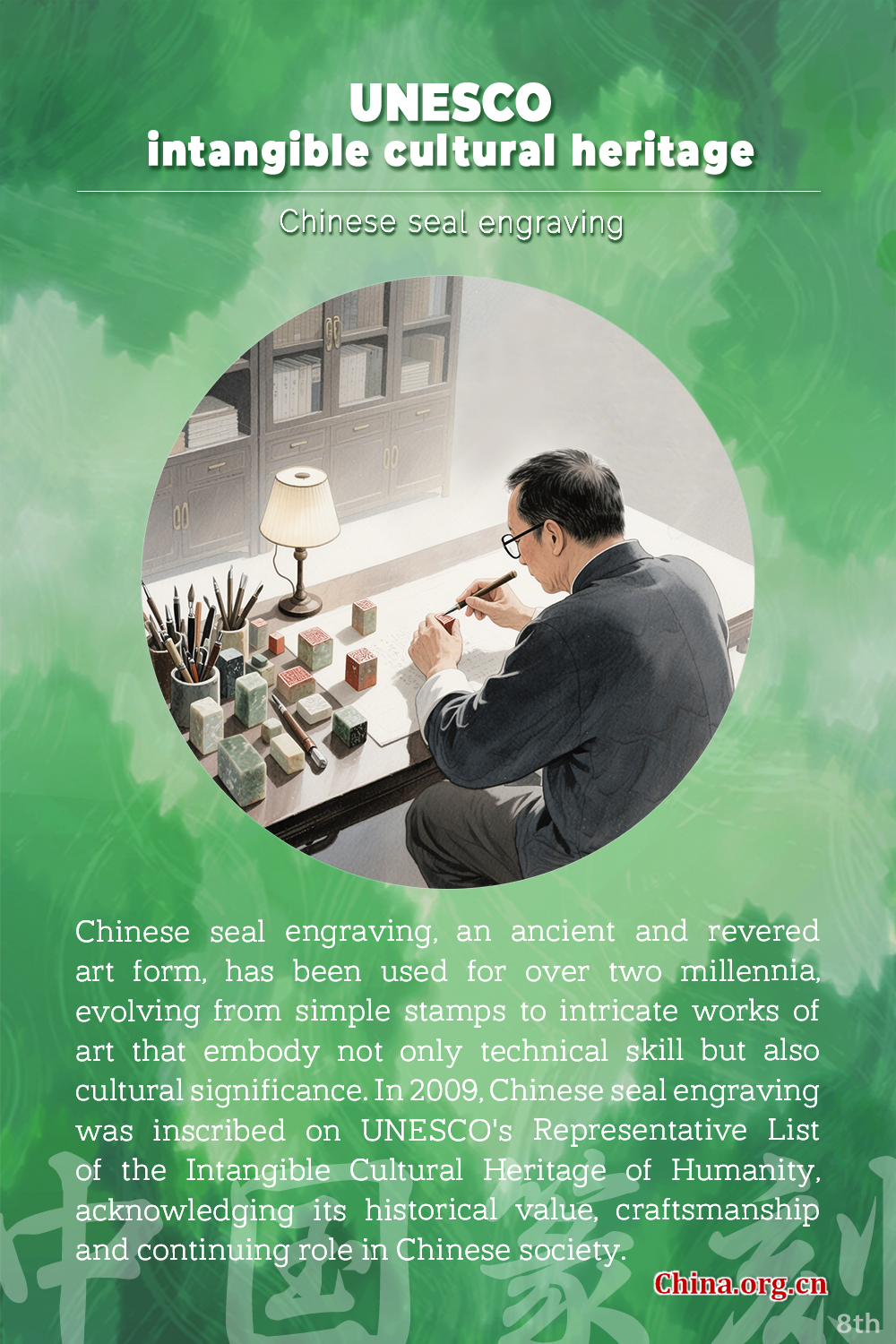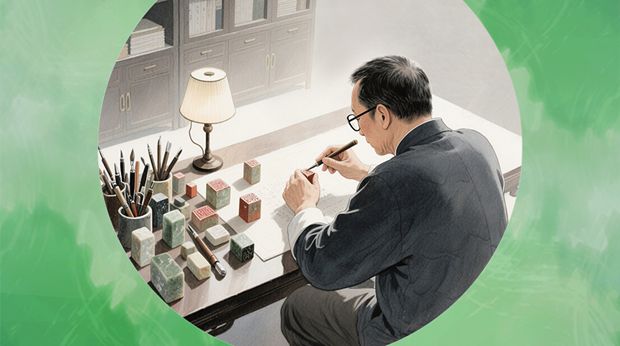Editor's note: Chinese seal engraving, an ancient and revered art form, has long been a central part of China's cultural heritage. The practice involves carving characters, symbols and motifs onto seals — often made from materials such as stone, jade and wood — which are then used to stamp or "seal" official documents, artworks and personal correspondence.

This art form has been used for over two millennia, evolving from simple stamps to intricate works of art that embody not only technical skill but also cultural significance. In 2009, Chinese seal engraving was inscribed on UNESCO's Representative List of the Intangible Cultural Heritage of Humanity, acknowledging its historical value, craftsmanship and continuing role in Chinese society.
The origins of Chinese seal engraving can be traced back to the Shang dynasty (1600–1046 BC), where the earliest examples of seals were found on oracle bones, used for divination. During this period, seals were used as a mark of authority, primarily by kings and nobility. The engraving was initially rudimentary, with simple inscriptions carved into the surface of the seal.
By the time of the Qin dynasty (221–207 BC), the use of seals had become more widespread. Emperor Qinshihuang standardized the seal format for official use, and it became a symbol of imperial power. Seals during this period were typically square, and the inscription was often the title or the name of the emperor or government official. This standardization paved the way for the flourishing of seal engraving throughout Chinese history.
During the Tang (618–907) and Song (960–1279) dynasties, scholars and artists began to use seals as a form of personal expression, incorporating fine calligraphy, elaborate motifs, and even poetic inscriptions into the designs. These designs often reflected the personality or aspirations of the owner, making each seal a unique artistic creation.
The Ming (1368–1644) and Qing (1644–1911) dynasties saw further refinement in the techniques of seal engraving. The development of specialized tools, such as the seal engraving knife and the increased use of jade and other precious materials, allowed artists to carve more detailed and sophisticated designs. In this period, seals became integral not only to official documentation but also to the personal and social lives of Chinese individuals, particularly scholars, artists and government officials.
Today, Chinese seal engraving remains a respected and vibrant art form, though its practice has been affected by modern technological developments. While seals are still used in official capacities, particularly in legal, governmental and corporate settings, the role of the seal as a cultural object of personal expression has shifted. Seal engraving continues to be a respected craft, particularly in the realm of Chinese calligraphy and painting, where artists often use seals to mark their works.
The art of seal engraving is taught in specialized schools and workshops, where traditional techniques are passed down from master engravers to apprentices. The use of seals in the world of modern art and literature continues to thrive, and many contemporary Chinese artists still carve their personal seals to complement their work.
However, like many traditional art forms, Chinese seal engraving faces challenges in the modern era. Rapid urbanization and the growth of digital communication technologies have reduced the demand for traditional seals in daily life. Yet, the cultural significance of seal engraving has been preserved through academic and cultural initiatives aimed at protecting and promoting this art form. Museums, galleries and exhibitions devoted to Chinese seal engraving continue to draw attention to its historical and artistic value, helping to ensure that the craft is kept alive for future generations.
In its recognition of Chinese seal engraving, UNESCO emphasized the art form's exceptional cultural value, noting its importance in both Chinese history and contemporary life. The organization praised the intricate craftsmanship involved in seal engraving, which combines technical skill with artistic expression. UNESCO also highlighted the role of seals in Chinese cultural practices, such as calligraphy, painting and poetry, where they serve as personal emblems and symbols of identity.
UNESCO further stressed the need for preserving the art of seal engraving, particularly as it faces challenges from modern technology and the loss of traditional knowledge. The organization's recognition aims to raise awareness of the importance of preserving both the techniques and the cultural context in which the craft is practiced. UNESCO's designation serves not only to honor the artistry of Chinese seal engraving but also to promote its continued transmission through education, research and cultural exchange.
By inscribing Chinese seal engraving on the Representative List of Intangible Cultural Heritage, UNESCO has reaffirmed its value as an enduring cultural practice that connects the past with the present, highlighting the way traditional arts continue to shape and enrich cultural identity in the modern world.
Discover more treasures from China on UNESCO's ICH list:
? 2024: Spring Festival
? 2022: Traditional tea processing
? 2020: Wangchuan ceremony, taijiquan
? 2018: Lum medicinal bathing of Sowa Rigpa
? 2016: Twenty-four solar terms
? 2013: Abacus-based Zhusuan
? 2012: Training plan for Fujian puppetry performers
? 2011: Shadow puppetry, Yimakan storytelling
? 2010: Peking opera, acupuncture and moxibustion, wooden movable-type printing, watertight-bulkhead technology of Chinese junks, Meshrep
? 2009: Yueju opera, Xi'an wind and percussion ensemble, traditional handicrafts of making Xuan paper, traditional firing techniques of Longquan celadon, Tibetan opera, sericulture and silk craftsmanship, Regong arts, Nanyin, Khoomei, Mazu belief and customs, Dragon Boat Festival, Manas, Craftsmanship of Nanjing Yunjin brocade, Xinjiang Uygur Muqam art, Hua'er, China engraved block printing technique, Chinese traditional architectural craftsmanship for timber-framed structures, Chinese paper-cut, Chinese calligraphy
? 2008: Kunqu opera, Guqin







 京公網(wǎng)安備 11010802027341號
京公網(wǎng)安備 11010802027341號 主站蜘蛛池模板:
女人洗澡一级毛片一级毛片|
欧美三级视频网站|
国产一区二区三区在线观看视频|
jizz国产视频|
国产麻豆媒一区一区二区三区|
一区二区三区在线|日本|
日本三级免费看|
久久精品水蜜桃av综合天堂|
欧美多人性受xxxx喷水|
亚洲热在线视频|
狠狠操视频网站|
免费观看性欧美大片无片|
翁情难自禁无删减版电影|
国产在线一区二区杨幂|
免费看污成人午夜网站|
国产精品国产高清国产av|
97超级碰碰碰碰久久久久|
天天操综合视频|
免费黄色网址在线观看|
色伦专区97中文字幕|
国产亚洲一路线二路线高质量|
国产乱码精品一区二区三区中|
国产精品哟哟视频|
4480yy私人影院论|
国产色婷婷精品综合在线|
99j久久精品久久久久久|
坐公交车弄了2个小时小视频|
caopon国产在线视频|
女大学生的沙龙|
一个人看的免费观看日本视频www
一个人看的免费视频www在线高清动漫
|
欧美日韩亚洲国内综合网香蕉|
亚洲精品国产综合久久一线|
狠狠精品干练久久久无码中文字幕|
免费看大美女大黄大色|
精品久久洲久久久久护士|
动漫乱人伦视频在线观看|
精品国产麻豆免费人成网站|
午夜看片在线观看|
精品无码成人久久久久久|
午夜精品福利视频|
国产精品真实对白精彩久久|
主站蜘蛛池模板:
女人洗澡一级毛片一级毛片|
欧美三级视频网站|
国产一区二区三区在线观看视频|
jizz国产视频|
国产麻豆媒一区一区二区三区|
一区二区三区在线|日本|
日本三级免费看|
久久精品水蜜桃av综合天堂|
欧美多人性受xxxx喷水|
亚洲热在线视频|
狠狠操视频网站|
免费观看性欧美大片无片|
翁情难自禁无删减版电影|
国产在线一区二区杨幂|
免费看污成人午夜网站|
国产精品国产高清国产av|
97超级碰碰碰碰久久久久|
天天操综合视频|
免费黄色网址在线观看|
色伦专区97中文字幕|
国产亚洲一路线二路线高质量|
国产乱码精品一区二区三区中|
国产精品哟哟视频|
4480yy私人影院论|
国产色婷婷精品综合在线|
99j久久精品久久久久久|
坐公交车弄了2个小时小视频|
caopon国产在线视频|
女大学生的沙龙|
一个人看的免费观看日本视频www
一个人看的免费视频www在线高清动漫
|
欧美日韩亚洲国内综合网香蕉|
亚洲精品国产综合久久一线|
狠狠精品干练久久久无码中文字幕|
免费看大美女大黄大色|
精品久久洲久久久久护士|
动漫乱人伦视频在线观看|
精品国产麻豆免费人成网站|
午夜看片在线观看|
精品无码成人久久久久久|
午夜精品福利视频|
国产精品真实对白精彩久久|